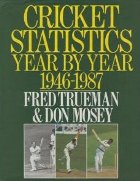Cricket Statistics Year by Year 1946-87
David Taylor |Published: 1988
Pages: 205
Author: Trueman, Fred and Mosey, Don
Publisher: Guild Publishing
Rating: 3 stars

In the late 1980s I was a member of a cricket book club, and with a little more disposable income than I had once I became a husband and father, acquired quite a few titles in a short period. This is one that’s been lying around on shelves unread for many years, so I thought it would be interesting to take another look at it. The authors will need little introduction: Trueman was for many people (and certainly in his own estimation) the finest fast bowler to ever put on an England shirt, with a long and varied post-playing career which included a memorable and often parodied stint as a summariser on Test Match Special. There his colleagues included Mosey, an equally blunt and forthright Yorkshireman, whose nickname, “The Alderman” doubtless given to him by Brian Johnston, perfectly reflected his rather pompous air.
There is no introduction, which would have been helpful, so we go straight into 1946 and the first full postwar season in England, when the visitors were an Indian side led by the Nawab of Pataudi, who’d played briefly for England. At the start of each season’s summary is the “statistics” promised by the title: the Test averages for England players, the Championship table – and, in later seasons, the winners of one-day competitions, also referred to in the text – and the first ten of the first-class batting and bowling averages. There is no “filter” in the averages, a minimum number of runs or wickets, so an unlikely character such as Ray Baker of Surrey, who topped the batting in 1977 by making 215 runs in 12 innings, nine of them not out, gets his moment in the sun again.
After the stats we have a round-up of each season from both an international and domestic viewpoint, in which the two Yorkshiremen take alternate paragraphs. On the whole they are more generous (and less resentful of the success of soft southerners) than you might expect. I was expecting plenty of “in my day” type material as gloriously parodied by the Monty Python crew, but there isn’t much – Fred has a bit of a grumble about his Test wicket record being overtaken, and Mosey speaks up for his old mate, but that’s about as grudging as it gets. It’s worth pointing out that more than 20 years later, and almost half a century after Trueman’s last match, only two England bowlers have gone past him, which, given the proliferation of Test cricket since then, really puts his achievement into perspective. What might he have done if the selectors were minded more often to pick him for tours?
It may be as well that these characters are no longer with us – they weren’t exactly enamoured with the game in the 1980s, so what they would think of the IPL scarcely bears thinking about. This is a worthwhile addition to a cricket library though, with illustrations on almost every page (not always the obvious subjects) and the two writers do a worthy job. A solid three from me for this one.






Leave a comment